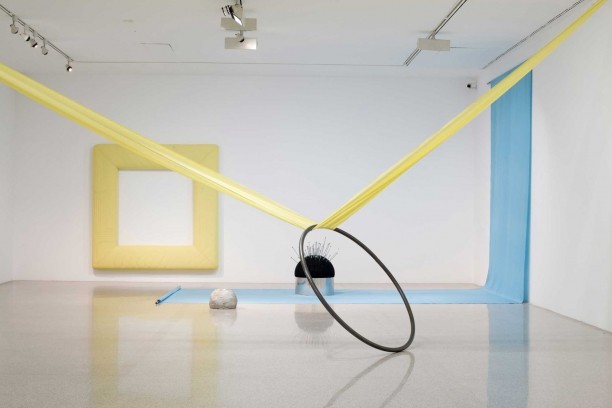Jenni Tischer
18 Oct 2014 - 01 Feb 2015
JENNI TISCHER
Pin
Baloise Art Prize 2013
18 October 2014 - 1 February 2015
Curated by Manuela Ammer
In Jenni Tischer’s exhibition Pin at mumok the vocabulary of minimalist sculpture comes up against the history and practice of textile work.
Reminiscent of unrolled scrolls, situation-adaptable and colored “fabric pedestals” cut across the room. Interlocking walls and floor, they display a number of sculptures: open cubes that feature “Viennese netting” like Thonet chairs, and objects whose materiality or form allude to weaving frames and pin cushions. Unlike conventional exhibition setups, Tischer’s arrangement leaves the question open as to what is part of the display and what is an art work. Instead, display elements such as pedestals or frames form an integral part of the narrative.
Pin addresses fundamental questions: What is a medium, and what kind of information can it convey? How are work processes inscribed in materials and surfaces? And why do textiles, as field of discourse and practice, have a momentum in the digital age? In-between “pins” (needles) and PINs (personal identification numbers), Tischer’s exhibition stakes out a realm where questions of the memory of materials and the encoding of identities are equally considered.
Pin
Baloise Art Prize 2013
18 October 2014 - 1 February 2015
Curated by Manuela Ammer
In Jenni Tischer’s exhibition Pin at mumok the vocabulary of minimalist sculpture comes up against the history and practice of textile work.
Reminiscent of unrolled scrolls, situation-adaptable and colored “fabric pedestals” cut across the room. Interlocking walls and floor, they display a number of sculptures: open cubes that feature “Viennese netting” like Thonet chairs, and objects whose materiality or form allude to weaving frames and pin cushions. Unlike conventional exhibition setups, Tischer’s arrangement leaves the question open as to what is part of the display and what is an art work. Instead, display elements such as pedestals or frames form an integral part of the narrative.
Pin addresses fundamental questions: What is a medium, and what kind of information can it convey? How are work processes inscribed in materials and surfaces? And why do textiles, as field of discourse and practice, have a momentum in the digital age? In-between “pins” (needles) and PINs (personal identification numbers), Tischer’s exhibition stakes out a realm where questions of the memory of materials and the encoding of identities are equally considered.

